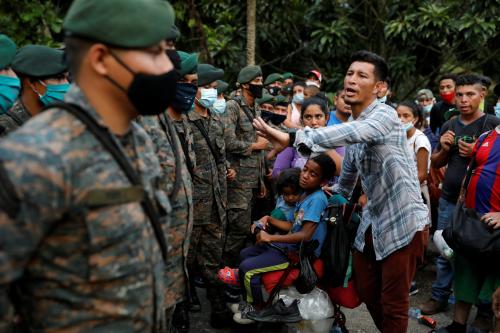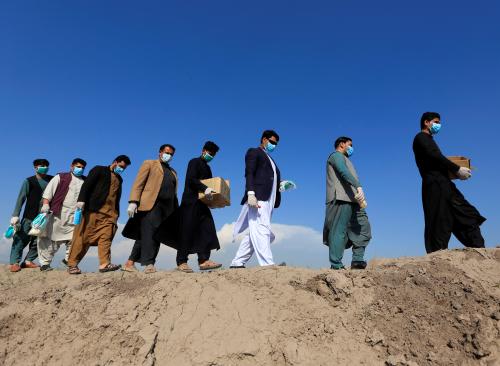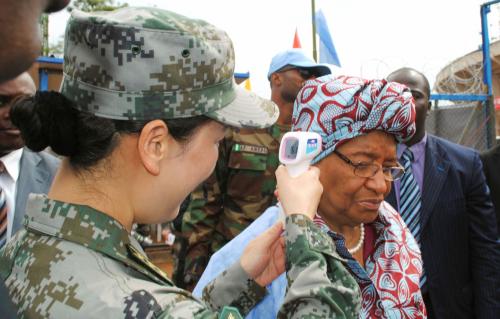The U.S. Global Fragility Act (GFA) is groundbreaking legislation that elevates the challenges of fragility. It calls for the U.S. government to adopt new ways of working to better assist fragile states. The White House recently announced the long awaited list of countries and regions where the GFA will be piloted over a 10-year period, guided by a U.S. global fragility strategy.
The strategy lays out a critical, but also wide-ranging and ambitious framework to help fragile states exit their predicament. The concern is how to implement such an ambitious framework—which includes promoting human rights and the rule of law, as well as strengthening service delivery, governance, and security institutions, and improving early warning mechanisms and natural resource management—while also fostering a more vibrant civil society, private sector, and free media.
To effectively guide these efforts, the U.S. government must focus on three core elements of the strategy that collectively provide for the strategy’s organizing framework, method of planning and operations, and venue for strategic partnerships, dialogue, and collective action.
These core elements align with an emerging “fragility to resilience” paradigm within the development community, which is focused on achieving more effective foreign assistance and development cooperation.
We highlight the three major elements below and recommend next steps.
1. A fragility to resilience approach
The U.S. global fragility strategy is focused on four goals—prevention, stabilization, partnership, and management. While not apparent from these goals, the strategy’s implicit framework for attaining them is rooted in resilience. Resilience is the identification of potential complex risks of crises and the building of absorptive, adaptive, and transformative capacities to address these risks, their root causes, and ensuing crises.
The strategy affirms that the “United States will adopt a multi-pronged, multi-sectoral approach to strengthen the resilience of partner nations.” To do this, it outlines a framework using resilience language: “Fragile countries face an array of often compounding shocks and stresses that can include civil unrest, complex humanitarian emergencies, natural disasters, and economic volatility. The United States will align diplomacy (including public engagement), assistance, investment, defense engagement, and other tools to help partners end protracted or recurrent crises and absorb, adapt to, and recover from such shocks and stresses.”
The U.S. global fragility strategy’s use of resilience as a guiding framework is vital for the GFA’s successful implementation and aligns to new approaches to apply resilience for prevention and stabilization efforts. The “Pathways for Peace” report highlights the need to shift from an early warning to a risk and resilience perspective for more upstream prevention efforts, since early warning signals can often appear too late when options for redress are limited.
Moreover, if prevention fails, a resilience framework will have guided U.S. government efforts to strengthen local capacities to absorb and adapt to emerging shocks so they do not turn into full blown catastrophes, and to transform systems, institutions, and social contracts in the face of crises. While prevention has always been part of resilience thinking, it has for too long been placed in a programmatic silo. The Pathways report helps overcome this by observing that resilience is the best means of prevention.
A potential barrier to the strategy’s approach is that for many within the U.S. policy community, resilience is still synonymous with food security. To address this misconception, champions for a broader U.S. government approach to resilience must emphasize how other major donors (like the European Union and the Foreign, Commonwealth and Development Office) and multilateral institutions (like the Organization for Economic Cooperation and Development (OECD), World Bank, and United Nations) are embracing this shift. Likewise, they can highlight how the State Department and USAID programs for health and education have applied a wider notion of resilience for addressing fragility.
As the Bureau for Humanitarian Assistance finalizes its own framework to address complex crises, it could use resilience as an umbrella framework for relief and recovery efforts. Relief and recovery approaches are still too concentrated on meeting human needs and not on building resilient capacities to risks and crises.
To make best use of a resilience framework, the U.S. global fragility strategy must use political settlements analysis to identify patterns of clientelism and elite capture that create the root causes of exclusion and make marginalized groups more vulnerable to crises. The strategy refers to the need for political will, but this reference tends to oversimplify complex patterns of patronage that can block the best intentions—political will—of national reformers. There is a widening research agenda linked to elite bargains, governance reform, and service delivery in violent contexts, and anti-corruption that can contribute to politically informed approaches to strengthen partner countries’ resilience.
2. Adaptive management
Just as the adage goes that planning is essential but plans are useless, so too would be the U.S. global fragility strategy without an adaptive management approach.
All too often, aid is delivered through preconceived solutions and rigid approaches for implementation that fix the resources, partners, and timelines without the ability to change in the face of risks, crises, or new learnings into complex political economies.
Adaptive methods allow for more dynamic collaboration with local stakeholders, intentional learning, and course correction in the face of fragility. The GFA requires a 10-year approach to various fragile states and recognizes the need to institutionalize adaptive management, potentially its greatest achievement.
The U.S. government—and particularly USAID—have made significant strides to make assistance more adaptive. This includes efforts for adaptive procurement processes and more rigorous learning approaches to fragile contexts.
Adaptive management must increasingly shift from the preserve of small projects to portfolio approaches within the U.S. government to share contextual insights, determine what is working and shift resources accordingly, and provide leadership signals and “psychological safety” for teams to experiment with riskier approaches based on evidence, but more often on well-reasoned hypotheses, as data is often notoriously hard to come by in fragile settings.
Beyond portfolio approaches, the U.S. government and broader development community must promote the use of adaptive management at the partnerships level to garner richer contextual and operational insights and pool greater resources from diverse stakeholders, as recently argued by the World Bank’s independent evaluation group.
3. Country platforms
Where they are possible, country platforms are the best venues for the U.S. government to promote adaptive management and partner with governments, civil society, business, and international partners. These are government-led bodies, typically designed to promote political and policy dialogue, mutual accountability, and collective action at high levels and through sector groups with support from a secretariat. Country platforms are not theoretical. They have been used by governments and donors for over two decades, but without the benefit of a guiding doctrine or learning agenda. The G-20, World Bank, United Nations Development Program, and OECD have all affirmed the value of supporting country platforms.
The U.S. global fragility strategy commits that “United States embassies and missions will establish coordination mechanisms for engaging regularly with national government counterparts, local civil society, and other stakeholders. They will review, align, and adapt plans and programs based on ongoing partner engagement and iterative conflict analysis, keeping other United States Government stakeholders periodically informed.”
The strategy’s emphasis on establishing coordination mechanisms that will work adaptively based on partner engagements and conflict analysis aligns well with the growing international consensus to support country platforms and adaptive approaches for greater impact. Country platforms can help discipline U.S. government efforts by anchoring them to country priorities and dynamics.
Among the newly announced GFA pilot countries, Haiti has experimented (with limited success) for over a decade with country platforms and Libya is preparing to establish a platform with multilateral support. Getting these mechanisms right across GFA pilot countries and regions will be critical for success.
Next steps
The U.S. global fragility strategy recommends widespread, ambitious, multisector reforms that could easily default to traditionally projectized, disjointed, and rigid attempts to deal with systemic breakdowns in institutions, markets, and social contracts in fragile states.
However, the strategy’s emphasis on resilience, adaptive management, and country coordination mechanisms has the potential to be a major change driver for realizing the GFA and should guide implementation. As U.S. interagency efforts pick up speed within the GFA senior-level steering committee and GFA working group to implement the strategy, this is the time to identify the critical path forward to promote more coordinated, adaptive, and resilient solutions to help those fragile states in the hardest places.







Commentary
From fragility to resilience: Recommendations for implementing the US global fragility strategy
April 13, 2022